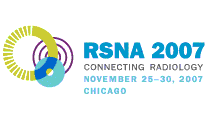
Abstract Archives of the RSNA, 2007
Than Kehwar DSC, Presenter: Nothing to Disclose
Saiful Huq PhD, Abstract Co-Author: Research grant, Varian Medical Systems, Inc
Dwight E. Heron MD, Abstract Co-Author: Nothing to Disclose
New concepts of biologically effective equivalent uniform dose(BEEUD) to compute tumor control probability(TCP) and NTCP. Background: In this work, the Normal tissue complication probability(NTCP) model proposed by Kehwar(1995) is used, which is an extension of Zaider and Amols(1999) radiobiological NTCP model.
For non-uniform dose distributions TCP and NTCP formulas, for uniform dose distribution, can not be applied. Therefore, to derive relations for tumor and normal tissues/organs to account for non-uniform dose distributions, respective volumes were divided into ‘n’ number of voxels of infinitesimally small volumes. It is assumed that uniform dose distribution exists within each voxel. Since TCP relation is an additive term of volume, its value for entire tumor can be obtained by calculating for every voxel and taking a sum. On the other hand, NTCP relation is not an additive term of volume. Therefore, it was formulated in volume additive form, known as NTCP factor(NTCPF), and calculated voxel by voxel for entire normal tissue/organ. It is assumed that BEEUD is the biological dose that gives equivalent TCP in tumor and NTCPF in normal tissue/organ to that of a uniform dose. By equating voxel based net TCP/NTCPF to that for BEEUDs, relations for tumor and normal tissue, can be given byBEEUDt=(1/a)ln[(1/V)Siviexp(-aBEDti)] (1)andBEEUDn=(k/a)ln[Si{(Vi/V0)exp[(a/k)BEDni]}] (2)Where V=total tumor volume, V0=total/reference normal tissue/organ volume, vi, Vi, BEDti and BEDni are volumes and BEDs of ith voxel of tumor and normal tissue/organ respectively, and i=1, 2, 3¼¼.n, k is tissue-specific parameter for normal tissues/organs. The subscripts ‘t’ and ‘n’ denote the tumor and normal tissue, respectively.Using BEEUDs, TCP for prostate, and NTCP for bladder, rectum and femurs, were calculated for two IMRT plans generated using Eclipse planning system for sample CTs. Here, PTV1 is designed with 1 cm margin to prostate and seminal vesicles(prostate+seminal vesicles+1.0cm), and PTV2 with 0.75 cm to the prostate(prostate+0.75cm). Sequential IMRT Boot plan(SqIB): IMRT generated for 54Gy/27Fx to PTV1 followed by IMRT boost to PTV2 for 24Gy/12Fx. Simultaneous Integrated Boost plan(SIB): IMRT plan generated for 54Gy/27Fx to PTV1 and 78Gy/27Fx to PTV2. Maximum dose limits of 50Gy for bladder and femurs, 45Gy for rectum, priority of 80% and limiting volume to 10% were set. Differential DVH of both the IMRT plans were used to calculate BEEUDs to compute TCP and NTCP.
To compute TCP and NTCP, for both the plans, the published values of the parameters were used. Table-1 lists calculated TCP for published values of different parameters for SqIB and SIB plans. The NTCP for rectum and femurs was calculated for k ranging from 0.1 to 1.0 which are higher in SqIB plans than in SIB plans irrespective of the value of k. For bladder it is almost zero for both SqIB and SIB plans.
Proposed methods of TCP and NTCP calculations provide radiobiological assessment of TCP and NTCP, and may be useful to do pre-dose delivery assessment of the plans.
Kehwar, T,
Huq, S,
Heron, D,
Concept of Biologically Effective Equivalent Uniform Dose to Compute Tumor Control Probability and Normal Tissue Complication Probability for IMRT Plans. Radiological Society of North America 2007 Scientific Assembly and Annual Meeting, November 25 - November 30, 2007 ,Chicago IL.
http://archive.rsna.org/2007/6000214.html

